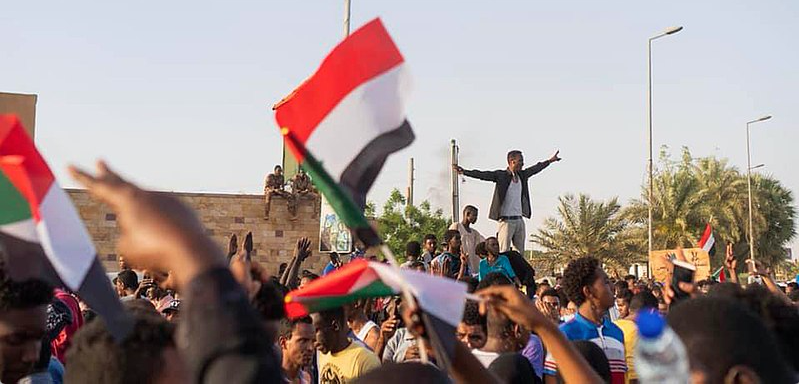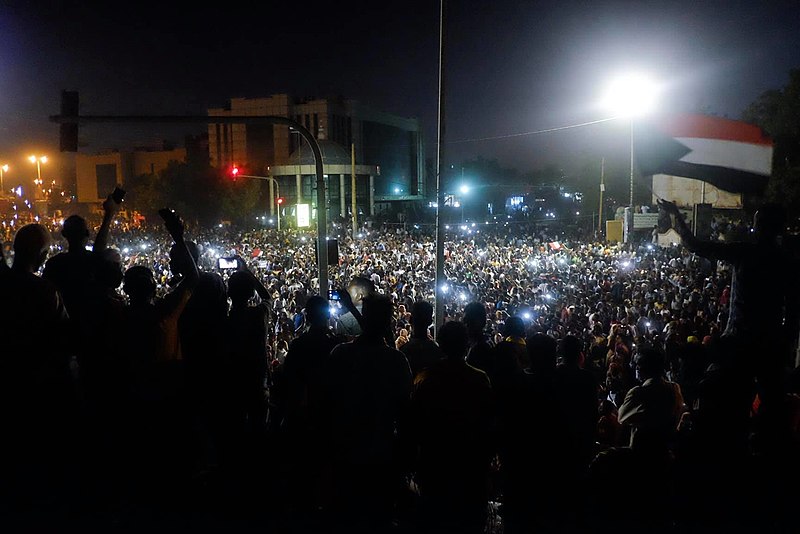Food Insecurity in Sudan and the Socioeconomic Impacts of Climate Change
By Lindsay Carroll
In December of last year, rising bread prices in the Nile city of ‘Atbara in Sudan helped catalyze a wave of protests against longtime President Omar al-Bashir’s government. The protests in ‘Atbara soon provided momentum to the country’s existing opposition movement, which had for years called for the overthrow of Bashir’s Inqaz regime, widely seen as corrupt, repressive, and brutal.

Protestors near an army HQ in Khartoum. Source: Wikimedia Commons
Sudan has a history rich in political activism: popular revolutions toppled military regimes decades before Bashir’s ouster, in 1964 and 1985. The dynamics behind civil unrest are complex, especially when they are of the magnitude that results in revolution. But it is clear that food insecurity, exacerbated by austerity measures and the country’s economic crisis, played a role in Sudan’s latest protest movement.
Agriculture, forestry, and fisheries accounted for 30.5 percent of Sudan’s GDP in 2017 – the 13th highest proportion in the world. Similar countries whose economies are highly reliant on agriculture and fishing are increasingly vulnerable as they face environmental challenges linked to climate change. In addition, the countries most impacted by such issues are also the least prepared to deal with them, according to an index compiled by Notre Dame University. With climate change seen as a potential “threat multiplier” in a security context, it is worth examining some of the major environmental changes Sudan faces as a case study for other parts of Africa, especially the Sahel.
Projected Environmental Changes and Impacts
Sudan expects to experience mean temperature rises of up to 3°C by 2050; though precipitation is expected to increase by 4 percent per decade, increasingly variable rainfall could mean more frequent droughts and floods. Areas on the Red Sea coast may experience effects of increased seawater temperatures and sea level rise.
The above factors—particularly increasing mean temperature and frequent droughts and floods—lead to desertification. This is a type of land degradation that occurs in dryland climates and is one of the top environmental issues that Sudan faces today. Also driven by human changes, desertification leads to less rain and decline in soil quality, turning once arable land infertile. In Sudan and other parts of Africa, deforestation, overgrazing, overcultivation, mining, and soil erosion are among the top human-led drivers of desertification.
The loss of arable land threatens livelihoods across the Sahel, where about 70 percent of people rely on farming. “There are almost no more trees, and the grass does not grow anymore, and so each year, we have to go further and further way to find grazing for our cattle,” a Senegalese cattle herder told the BBC in 2015. In Burkina Faso, lower rainfall and higher temperatures have been linked to increased evaporation and the spread of pests that contribute to land degradation, which reportedly affects 30 percent of the country’s land.

Protestors in Khartoum. Site: Wikimedia Commons
Climate changes including desertification contribute to a complex set of socioeconomic factors such as lower crop yields, decreased water resources, migration, and contestation of land use and water rights. They can fuel civil unrest and conflict, as vulnerable groups such as pastoralists and farmers compete over scarcer resources. Additionally, these issues are transnational in nature. For example, the Persian Gulf and other Middle Eastern countries, themselves seeking greater food security, have invested in agribusiness in cash-strapped potential breadbaskets in Sudan, Egypt, and the Horn of Africa, which are in need of foreign cash. Yet this has led to concerns about the impacts of this investment on domestic food and water security in those countries and local anger over land use, which may have contributed to the Sudanese uprising.
Globally, these factors have led the US Office of the Director of National Intelligence to conclude that climate change could have profound effects on the stability of countries through threats such as heightened social and political tensions, fluctuations in food prices and availability, and negative impacts on investment and economic competitiveness. These risks are identified on projected outcomes of the effects climate change may have on our world – but with such a diverse set of variables, a great deal of uncertainty remains.
Sudan’s environmental challenges and their associated socioeconomic impacts are a window into wider trends across Africa. As climate change impacts are increasingly observed in the coming decades, understanding the ways these issues interact with other grievances, such as inequality and political oppression, will become an ever-more important tool for determining risks to stability.

